Friday, November 30, 2012
Monday, November 5, 2012
A. Botsay

Before the street was renamed after Gov. Francis T. Nicholls, it was Hospital Street for 180 years. And 516 Hospital St. was the residence and business of Alexander Botsay, a pioneer cigar box maker of the South. It was about 1860 that Botsay introduced the cigar box industry to New Orleans. Before that, cigar boxes were imported.
Botsay came to New Orleans in 1856 from Budapest. He was a revolutionary when the Hungarians fought against Austria for their freedom. He married in New Orleans and eventually had a large family and a successful business.
When the Northern blockade cut off the city's supplies during the Civil War, Botsay saw an opportunity. He bought up old cigar boxes and reworked them for his trade. He did well, receiving as much as 50 cents per box.
Botsay stayed active in his business well into his eighties. He died Dec. 22, 1913.
Crescent City

The crescent that gave rise to our city's nickname runs from Canal Street to Esplanade Avenue, across from Algiers Point. It hugs a sharp, crescent-shaped bend of the river, and the moniker became popular in the early 1800s.
When Jean Baptiste Le Moyne Sieur de Bienville was looking for a place to build a city in the Louisiana Territory in 1718, he spotted a stretch of land on the river that was higher than the surrounding area. He reportedly was taken with the dramatic bend in the Mississippi River and its proximity to the nearby lake, which he named Pontchartrain. There was also a bayou that ran from the lake almost to the river. Most important, the spot for the city he planned would be ideal for monitoring river traffic.
Bienville apparently was so enchanted with the spot that he wasn't deterred by the cypress swamp that would have to be cleared, the potential for hurricanes and flooding, the heat and humidity, alligators or swarms of mosquitoes.
Thursday, October 18, 2012
Mid City Open House Saturday 10/20
OPEN HOUSE!!!
Hosted by Doris Lumpkin
Saturday October 20, 2012
come see me and this fabulous house!
Thursday, June 14, 2012

709 JACKSON AVENUE GARGOYLE
The building was constructed in 1867 for the congregation of Sha'arai Tefillah, which translates into "gates of prayer," but the architect did not include the gargoyle.
The old synagogue at 709 Jackson Ave. was sold in 2004, and the new owners installed new glass in the windows. Fearing vandals would see the windows as ideal targets, the owners took out a little insurance. Since gargoyles are said to scare off and protect from evil and harmful spirits, it seemed like a good idea to display one on the building. So they found a fiberglass gargoyle in a shop on Magazine Street and attached it to the building. They had to put it on the side instead of out front because of restrictions placed on them by a preservation group. It seems the gargoyle did its duty and kept window-smashers away.
Tuesday, May 29, 2012
New Orleans Architectural Styles
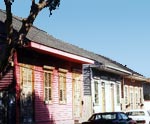 |
| Creole Cottage |
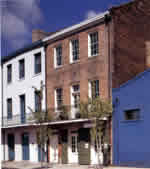 |
| American Townhouse |
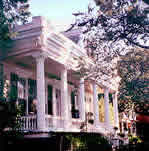 |
| Raised Center Hall Cottage |
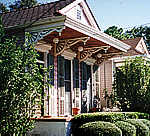 |
| Shotgun House |
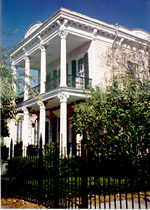 |
| Double Gallery House |
Creole Cottage
1790-1850. Found mainly in the French Quarter and surrounding area. Cottages are single story, set at ground level. Steeply pitched roof. Symmetrical four-opening facade wall, set close to front property line. Made of stucco or wood exterior.American Townhouse
1820-1850. Found in the Central Business District or Lower Garden District. A narrow three-story structure set near ground level. Facade wall on property line. Asymmetrical arrangement of facade openings, balcony on second floor. Exterior made of brick or stucco.Creole Townhouse
Not pictured. 1788-mid-1800s. Found in the French Quarter and surrounding neighborhoods. Two to four-story structure set at or near ground level. Asymmetrical arrangement of arched openings on facade wall set on property line. Iron balcony at second and sometimes third levels. Steeply pitched side-gabled roof often with multiple roof dormers. Brick or stucco exterior.Raised Center-Hall Cottage or Villa
1803-1870. Found in the Garden District, Uptown, Carrollton and elsewhere. One-and-a-half story house raised two to eight feet above ground on brick piers. Full-width front gallery framed by six columns supporting entablature. Five openings with front door in the center. Side-gabled roof, often broken by central dormer. Exterior made of wood.Shotgun House
1850-1910. Found throughout New Orleans. Usually one-story, but many with second story set at rear of house (called camelback). Narrow rectangular structure raised on brick piers. Most have narrow front porch covered by a roof apron and supported by columns and brackets, often with lacey Victorian ornamentation. Predominant New Orleans house type. Wood exterior.Double-Gallery House
1820-1850. Found in the Lower Garden District, Garden District, Uptown, Esplanade Ridge. Two-story structure raised on low brick piers. Side-gabled or hipped roof. Structure set back from property line. Covered two-story galleries framed by columns supporting entablature. Asymmetrical arrangement of facade openings.To learn more about the fabulous architecture found throughout New Orleans, visit the Preservation Resource Center at: www.prcno.org or book a trip to New Orleans and see this treasure trove filled with architectural gems.
Courtesy of neworleansonline.com
Wednesday, May 23, 2012
Home Performance Standards
ECOHOME 2012 Vision 2020
BLOGGER NOTE: As the Greater New Orleans housing industry turns its eye toward more energy efficiency and high performance homes, it is valuable to know that there are existing and rapidly improving performance standards to guide the consumer. For more information log onto: EcoHomeMagazine.com/Vision-2020.
Home Performance Standard Approved by ANSI
ANSI (The American Standards Institute) is a private non-profit organization that oversees the development and use of voluntary consensus standards for products, services, and systems. ANSI is headquartered in Washington, DC and was established in 1918.
By: Fernando Pages Ruiz
Posted by Kim Hunicke
BLOGGER NOTE: As the Greater New Orleans housing industry turns its eye toward more energy efficiency and high performance homes, it is valuable to know that there are existing and rapidly improving performance standards to guide the consumer. For more information log onto: EcoHomeMagazine.com/Vision-2020.
Home Performance Standard Approved by ANSI
ANSI (The American Standards Institute) is a private non-profit organization that oversees the development and use of voluntary consensus standards for products, services, and systems. ANSI is headquartered in Washington, DC and was established in 1918.
By: Fernando Pages Ruiz
Posted by Kim Hunicke
As remodeling codes rely increasingly on achieving before-and-after performance standards, and therefore on home performance auditors to make the initial assessment, provide recommendations, and then certify the completed product, it also becomes necessary to have strict standards for the standard bearers. In other words, minimum criteria to identify existing deficiencies in residential buildings, suggest improvements, and evaluate that the subsequent work done was completed in accordance with industry-recognized procedures. The Air Conditioning Contractors of America and the Residential Energy Services Network (RESNET) cooperated in the development of the first ANSI-recognized Standard for Existing Homes Evaluation and Performance Improvement (ANSI/ACC 12 QH 2011). RESNET will now use the Standard as the foundation for its Energy Smart Contractor designation.
Unlike earlier standards that focused on energy almost exclusively, the new Home Performance Standard establishes minimum requirements to evaluate a residence with regards to energy efficiency, water conservation, occupant comfort, and indoor air quality. The Standard also describes how to prioritize potential improvement and present them to the building owner, i.e. how to sell the improvements, and a detailed checklist to verify that the work performed complies with current industry standards.
Friday, May 18, 2012
THIS WEEKEND!!!! The Boogaloo Goes On Rain or Shine...
Founded during the evacuation of Hurricane Katrina, the Mid City Bayou Boogaloo has shown its commitment to New Orleans through rain or shine, and this year's festival is no different. The event will occur Friday (evening), Saturday and Sunday, rain or shine. Please show your passion for the Bayou Boogaloo and all the great things New Orleans has to offer.
Founded during the evacuation of Hurricane Katrina, the Mid City Bayou Boogaloo has shown its commitment to New Orleans through rain or shine, and this year's festival is no different. The event will occur Friday (evening), Saturday and Sunday, rain or shine. Please show your passion for the Bayou Boogaloo and all the great things New Orleans has to offer.
The festival features three live music stages, both acoustic and electric with a wide variety of musical genres including New Orleans roots in Blues, Jazz , Funk, Cajun, Zydeco, Latin, Brass, Country, Alternative, Hip Hop and Rock. Visit http://thebayouboogaloo.com for more information.
Thursday, May 17, 2012
Mid-City
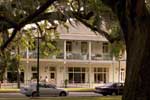 |
 |
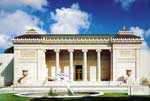 |
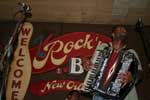 |
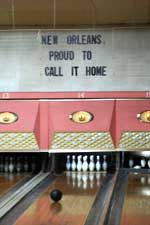 |
Mid-city showcases the spirit of a true neighborhood as defined by that unique measure of camaraderie found only in this city: It has its own Mardi Gras parading society. The Krewe of Mid-City, founded in 1933 by a group of area businessmen, is the fifth oldest Carnival marching organization in New Orleans.
In 1913 a young engineer named Albert Baldwin Wood made Mid-City habitable when he developed the screw pump, a device that allowed water to be pumped from land situated below sea level. Before that, this charming neighborhood was poorly drained swampland that was easily prone to flooding and generally swarmed with mosquitoes.
Turpentine works, lumberyards and other industries flourished along the New Basin Canal, dug in 1832 on the present path of Interstate 10, and along Canal Street. The whole area was known as “back ‘o town” because it was “back of” the natural levees along which the city first developed. Mid-City is attractive today for several reasons including its beautiful oak-lined avenues, like Jefferson Davis Parkway - the second widest street in the city.
World-class exhibitions at the New Orleans Museum of Art come literally to residents' doorsteps, and the annual Celebration in the Oaks turns the park into an elaborate exhibit of holiday lights. Right next to the museum, stroll the beautiful Besthoff Sculpture Garden.
Two American pastimes, Bowling and Rock ‘n Roll, merge as live music floats onto the lanes at Mid-City Lanes Rock ‘n Bowl®, and Thursday afternoons bring the Crescent City Farmers Market to the American Can Company – also a great place to grab some coffee or a dinner near the bayou - on Orleans Avenue. On the other side of Bayou St. John, headed back downtown, Parkway Bakery and Tavern serves up po’boys and live music on the weekends.
The streetcar that linked this part of Canal Street to the Central Business District from 1861 to 1964 has been restored. Its fixed rail lines prove an incentive for more visitors to discover this convenient district in the heart of the city. A trip in the streetcar can take two routes. The Cemetery cars will take you to the end of Canal to several vast cemeteries – New Orleans “Cities of the Dead” named so because of the unique, ornate, above-ground tombs. If you are looking for a bite before this trip, try hopping off at Canal and Carrolton. Otherwise, there are plenty of spirits and food to be found just a block or two from the cemeteries at Liuzza’s or the Bulldog. The City Park streetcar let’s off near the New Orleans Museum of Art at the end of Esplanade Avenue.
Esplanande Ridge
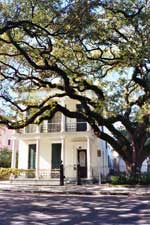 |
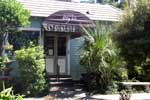 |
 |
In 1822 City Surveyor Joseph Pilie mapped the “Esplanade Prolongment” but it would be years before the planned European-style boulevard connecting the Vieux Carre to the bayou would become a reality. Long before the street arrived, however, prominent New Orlenians were building country houses and manor homes along Bayou Road and on large parks dotted across the then-rural area that is now the historic district.
At the same time, the area’s association with The New Orleans Jazz and Heritage Festival, which is held each Spring in the nearby Fairgrounds, makes the Esplanade Ridge a favorite with artists, musicians, and music lovers.
Both the racetrack and the New Orleans Museum of Art are within walking distance, and public transit puts the downtown and uptown universities within easy reach. The shops and restaurants in the 3000-3200 blocks of Esplanade Avenue are a community haven to the residents.
Tuesday, January 10, 2012
Refinance your mortgage (again)?
Consumer Reports January 2012
Some 58 percent of the homeowners who have mortgages – that’s about 28 million house-holds – pay interest rates that are higher than today’s bargain rates. Many could save thousands by refinancing. Are you one of them?
Trading in a higher-rate mortgage for a cheaper one has become almost ritual in the past two decades. Some homeowners refinanced several times as interest rates on 30-year fixed mortgages went from around 10 percent in the early 190s to about 4 percent in early November, when rates were at their lowest levels in 50 years.
LONG-TERM SAVINGS
That has created yet another opportunity to cut your monthly mortgage payments or accelerate your home’s payoff by refinancing into a shorter-term loan, which can slash your total interest costs.
How much can you gain from refinanacing? If you took out a 30-yea, $200,000, 6.7 percent motgage five years ago, your monthly payment is almost $1,300. Refinance the $188,000 balance with a 25-year, 4 percent mortgage, and your payment would drop by $300 per month, saving you $90,000 in finance charges over 25 years.
Rates on 15-year mortgages are even lower, averaging 3.4 percent in early November. Shortening the loan term often results in a higher monthly payment. If you refinanced the above five-year-old loan to a 15-year, 3.3 percent mortgage, your monthly payment would go up by about $30, But by paying off your loan 10 years sooner, you’d save $149,000 in interest.
You’ll get the biggest savings from refinancing early in your loan term, but if you can slash your rate, you can still save even if you have less than 10 years left on your mortgage. For example, if you have six years left on a 15-year, 5.6 percent mortgage written in 2002 and you refinanced to a 15-year 3.6 percent mortgage, you’d cut your monthly payments by $922. You’d also extend your mortgage by six years, which would increase your total interest costs by $11,600. But if you paid and additional $850 each month toward your principal, you’d pay off the new loan in six years and save about $6,800 in interest.
To crunch the numbers on your own specifics, try the calculator at www.hsh.com/refinance-calculator. The calculator accounts for closing costs, about 2 percent of the principal, and can be paid out of pocket or folded into the loan amount.
DO YOU QUALIFY?
The best candidates for refinancing have regular income, at least 10 to 20 percent equity in their homes, and a FICO credit score of 740 or better. But borrowers with scores as low as 620 can qualify for a FHA mortgage, which are available through banks, credit unions, and other lenders. People who don’t meet those criteria might have to jump over hurdles.
Low equity. If you’re under water, owing more than your home is worth, you might get help from the federal home affordable refinance program. When it was introduced in early 2009, HARP allowed refinancing for up to 125 percent of value for mortgages owned or guaranteed by Fannie Mae or Freddie Mac. “The program was badly designed,” says Keith Gumbinger, vice president of HSH Associates, a rate-comparison service, “because it asked lenders to take on additional risk for no reward-a lower interest rate.” In October, the Federal Housing Finance Agency announced that HARP would be revamped to reduce fees and remove the 125 percent loan-to-value limit that kept severely underwater homeowners from refinancing. The changes could prompt 2 million new refinances in the coming year according to CoreLogic, an information and analytics firm.
If you have a home equity line of credit or second mortgage on the property and can pull together the cash, try to pay that off, advises Chris Goode, mortgage product manager at Informa Research, a financial-market-research company. That will increase your equity by reducing the amount of debt against the property.
Reduced Income. If you income has dropped since you got your mortgage, you might not be able to get a straight refinance. If you can afford about three-quarters of your payment, you might qualify for a loan modification. “Some lenders just change the rate lower,” Goode says.
Unemployment. You probably won’t be able to refinance without a regular income. But you might be eligible for relief through forbearance – the lender lets you suspend or make partial payments for up to 12 months while you search for a job. You might also be eligible for a reduction in principal through the Hardest Hit Fund, a federal foreclosure prevention program in markets where home prices have collapsed the most. Check with your lender or go to www.makinghomeaffordable.gov.
Subscribe to:
Posts (Atom)

